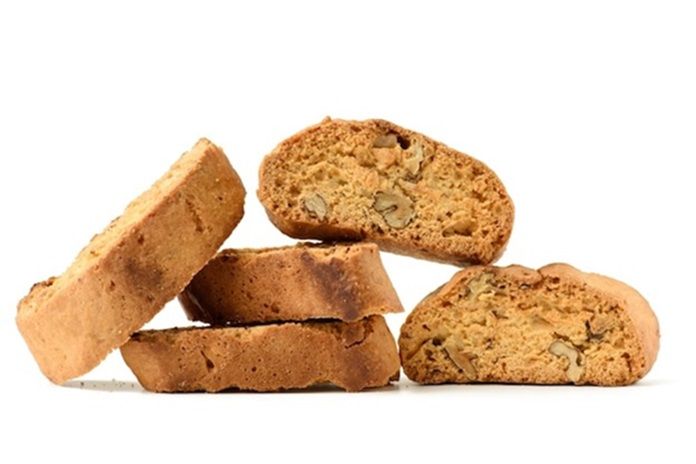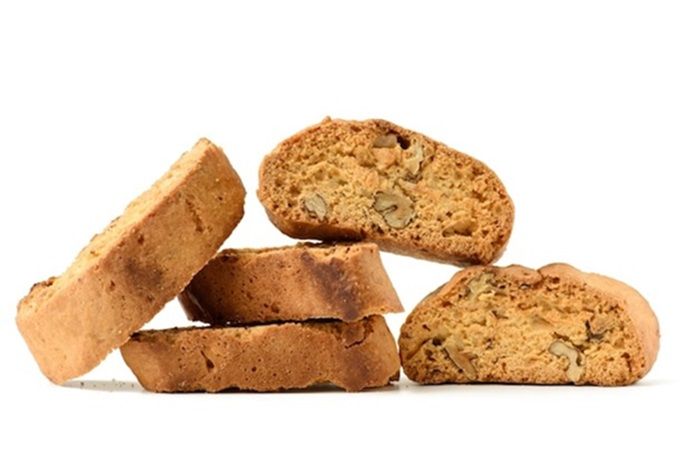National Biscotti Day is celebrated on September 29. Biscotti is a traditional European cookie that’s crunchy and very tasty. People enjoy it on its own, with a meal, or with coffee—whether dipped, dunked, or eaten plain. Today, biscotti comes in many flavors like almond, cappuccino, pistachio, pine nuts, and raisins.
History of National Biscotti Day
National Biscotti Day has an interesting history. Biscotti, which you can find and enjoy in many ways, is a great choice for vegetarians or those on a diet. Its origins trace back to ancient Rome and it was later popularized in Tuscany.
The name “biscotti” comes from the Latin word “biscoctus,” meaning “twice-baked.” This double baking makes the cookie dry and less likely to spoil, so it was perfect for travelers and soldiers to carry with them.
In Tuscany, where there are many almond groves, the biscotti recipe was adapted to include unroasted almonds. Biscotti is also known as “Cantucci,” although this term can refer to various versions of the cookie made in Tuscany.
Biscotti is also linked to Palm Sunday, where ‘currutacos’ (biscotti with almonds) are used as decorations on palm leaves given to worshippers in Garraf, a region in Spain.
In Tuscany, people traditionally enjoy biscotti dipped in Vin Santo, a sweet wine that pairs perfectly with the cookie. Vin Santo is not only the ideal match for biscotti but is also used in some Catalonian recipes, including rice and sardine dishes, onion sauces, and even in the sauce for turnip-stuffed duck in one Spanish region.

Biscotti came to America thanks to Christopher Columbus, who used it as food during his voyage. Over time, the cookie has evolved and now can be enjoyed in various ways. Today, you can have biscotti with tea, coffee, cold chai, or even in parfaits.
| 14th (Century Renaissance and Reincarnation.) | Biscotti re-emerges through the hands of a Tuscan baker, Antonio Mattei. |
| 18th (Century The First Recipe) | The first biscotti recipe is penned by Amadio Baldanzi. |
| 1891 (When the Founder Landed…) | Christopher Columbus brings biscotti to America. |
| 1990s (America Loves Biscotti) | Biscotti becomes an American favorite. |
Five Interesting Facts About Biscotti
Origins in Ancient Rome: The word “biscotti” comes from the Latin term biscoctus, meaning “twice-baked.” This reflects the traditional method of baking the cookies twice to achieve their dry and crunchy texture. Ancient Romans enjoyed similar treats, though modern biscotti evolved in Italy.
Regional Varieties: While biscotti is commonly associated with Tuscany, where it’s known as “cantucci,” different regions of Italy have their own variations. For example, in Veneto, they might add almonds, while in other areas, they may include dried fruits or chocolate.
Traditional Pairing: Biscotti is traditionally served with vin santo, a sweet Italian dessert wine. The idea is to dip the biscotti in the wine, which softens the cookie and enhances the flavor of both the biscotti and the wine.
Health Benefits: Due to their dry and crunchy nature, biscotti often contain nuts and seeds, which can be a source of healthy fats, proteins, and fiber. This can make them a more nutritious choice compared to other sweet treats.
Biscotti and Coffee: In the United States, biscotti has become a popular accompaniment to coffee. Its sturdy texture makes it ideal for dipping into a hot beverage, a practice that has been embraced globally.
The Health Benefits of Biscotti
While biscotti is often enjoyed as a treat, it can also have some health benefits. Traditional biscotti recipes typically use almonds, which are a good source of healthy fats, protein, and fiber. Almonds are also rich in vitamins and minerals, including vitamin E, magnesium, and calcium.
The twice-baking process of biscotti means that it is lower in moisture compared to other cookies. This makes it less likely to become a breeding ground for bacteria and mold, potentially extending its shelf life. However, it’s still important to enjoy biscotti in moderation, as it can be high in sugar and calories.
Conclusion
National Biscotti Day on September 29 celebrates this crunchy, versatile cookie with deep historical roots. Originating in ancient Rome and popularized in Tuscany, biscotti was perfected for travel and has evolved into a favorite treat in America.
Whether paired with Vin Santo, coffee or enjoyed plain, biscotti’s nutty flavors and potential health benefits make it a delightful choice. So, take a moment on National Biscotti Day to savor this timeless cookie and its rich heritage.
Frequently Ask Question
1. What is National Biscotti Day?
National Biscotti Day is celebrated on September 29 to honor and enjoy biscotti, a traditional European cookie known for its crunchy texture and diverse flavors.
2. What is biscotti?
Biscotti is a twice-baked cookie that originated in ancient Rome and was later popularized in Tuscany. It is known for its dry, crunchy texture and can come in various flavors, including almond, cappuccino, and pistachio.
3. Why is biscotti called “biscotti”?
The name “biscotti” comes from the Latin word “biscoctus,” meaning “twice-baked,” which refers to the traditional baking process that gives biscotti its distinctive crunch.
4. How was biscotti historically used?
Biscotti’s dry texture made it ideal for travelers and soldiers in ancient times. It was a durable and portable food that could last longer without spoiling.
Also read, Hug A Vegetarian Day – September 27, 2024
